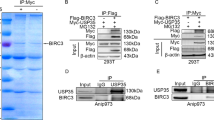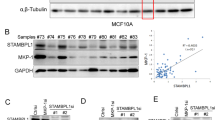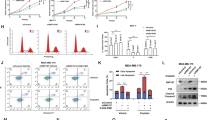Abstract
NEDL1 (NEDD4-like ubiquitin protein ligase-1) is a newly identified HECT-type E3 ubiquitin protein ligase highly expressed in favorable neuroblastomas as compared with unfavorable ones. In this study, we found that NEDL1 cooperates with p53 to induce apoptosis. During cisplatin (CDDP)-mediated apoptosis in neuroblastoma SH-SY5Y cells, p53 was induced to accumulate in association with an increase in expression levels of NEDL1. Enforced expression of NEDL1 resulted in a decrease in number of G418-resistant colonies in SH-SY5Y and U2OS cells bearing wild-type p53, whereas NEDL1 had undetectable effect on p53-deficient H1299 and SAOS-2 cells. Similarly, enforced expression of NEDL1 increased number of U2OS cells with sub-G1 DNA content. Co-immunoprecipitation and in vitro binding assays revealed that NEDL1 binds to the COOH-terminal region of p53. Luciferase reporter assay showed that NEDL1 has an ability to enhance the transcriptional activity of p53. Small interfering RNA-mediated knockdown of the endogenous NEDL1 conferred the resistance of U2OS cells to adriamycin. It is noteworthy that NEDL1 enhanced pro-apoptotic activity of p53 in its catalytic activity-independent manner. Taken together, our present findings suggest that functional interaction of NEDL1 with p53 might contribute to the induction of apoptosis in cancerous cells bearing wild-type p53.
This is a preview of subscription content, access via your institution
Access options
Subscribe to this journal
Receive 50 print issues and online access
$259.00 per year
only $5.18 per issue
Buy this article
- Purchase on Springer Link
- Instant access to full article PDF
Prices may be subject to local taxes which are calculated during checkout








Similar content being viewed by others
References
Adhikary S, Marinoni F, Hock A, Hulleman E, Popov N, Beier R et al. (2005). The ubiquitin ligase HectH9 regulates transcriptional activation by Myc and is essential for tumor cell proliferation. Cell 123: 409–421.
Bijur GN, De Sarno P, Jope RS . (2000). Glycogen synthase kinase-3beta facilitates staurosporine- and heat shock-induced apoptosis. J Biol Chem 275: 7583–7590.
Cluskey S, Ramsden DB . (2001). Mechanisms of neurodegeneration in amyotrophic lateral sclerosis. Mol Pathol 54: 386–392.
Cross DA, Culbert AA, Chalmers KA, Facci L, Skaper SD, Reith AD . (2001). Selective small-molecule inhibitors of glycogen synthase kinase-3 activity protect primary neurones from death. J Neurochem 77: 94–102.
Di Lello P, Jenkins LM, Jones TN, Nguyen BD, Hara T, Yamaguchi H et al. (2006). Structure of the Tfb1/p53 complex: Insights into the interaction between the p62/Tfb1 subunit of TFIIH and the activation domain of p53. Mol Cell 22: 731–740.
Donehower LA, Harvey M, Slagle BL, McArthur MJ, Montgomery Jr CA, Butel JS et al. (1992). Mice deficient for p53 are developmentally normal but susceptible to spontaneous tumours. Nature 356: 215–221.
Ekegren T, Grundstrom E, Lindholm D, Aquilonius SM . (1999). Upregulation of Bax protein and increased DNA degradation in ALS spinal cord motor neurons. Acta Neurol Scand 100: 317–321.
Gonzalez de Aguilar JL, Gordon JW, Rene F, de Tapia M, Lutz-Bucher B, Gaiddon C et al. (2000). Alteration of the Bcl-x/Bax ratio in a transgenic mouse model of amyotrophic lateral sclerosis: evidence for the implication of the p53 signaling pathway. Neurobiol Dis 7: 406–415.
Hetman M, Cavanaugh JE, Kimelman D, Xia Z . (2000). Role of glycogen synthase kinase-3beta in neuronal apoptosis induced by trophic withdrawal. J Neurosci 20: 2567–2574.
Hino S, Michiue T, Asashima M, Kikuchi A . (2003). Casein kinase I epsilon enhances the binding of Dvl-1 to Frat-1 and is essential for Wnt-3a-induced accumulation of beta-catenin. J Biol Chem 278: 14066–14073.
Hollstein M, Sidransky D, Vogelstein B, Harris CC . (1991). p53 mutations in human cancers. Science 253: 49–53.
Hupp TR, Lane DP . (1994). Regulation of the cryptic sequence-specific DNA-binding function of p53 by protein kinases. Cold Spring Harb Symp Quant Biol 59: 195–206.
Kiryo-Seo S, Hirayama T, Kato R, Kiyama H . (2005). Noxa is a critical mediator of p53-dependent motor neuron death after nerve injury in adult mouse. J Neurosci 25: 1442–1447.
Kishida M, Hino S, Michiue T, Yamamoto H, Kishida S, Fukui A et al. (2001). Synergistic activation of the Wnt signaling pathway by Dvl and casein kinase Iepsilon. J Biol Chem 276: 33147–33155.
Kitanaka C, Kato K, Ijiri R, Sakurada K, Tomiyama A, Noguchi K et al. (2002). Increased Ras expression and caspase-independent neuroblastoma cell death: possible mechanism of spontaneous neuroblastoma regression. J Natl Cancer Inst 94: 358–368.
Lee E, Salic A, Kirschner MW . (2001). Physiological regulation of [beta]- catenin stability by Tcf3 and CK1epsilon. J Cell Biol 154: 983–993.
Levine AJ, Chang A, Dittmer D, Notterman DA, Silver A, Thorn K et al. (1994). The p53 tumor suppressor gene. J Lab Clin Med 123: 817–823.
Martin LJ . (2000). p53 is abnormally elevated and active in the CNS of patients with amyotrophic lateral sclerosis. Neurobiol Dis 7: 613–622.
Martin LJ, Liu Z . (2002). Injury-induced spinal motor neuron apoptosis is preceded by DNA single-strand breaks and is p53- and bax-dependent. J Neurobiol 5: 181–197.
Miyazaki K, Fujita T, Ozaki T, Kato C, Kurose Y, Sakamoto M et al. (2004). NEDL1, a novel ubiquitin-protein isopeptide ligase for dishevelled-1, targets mutant superoxide dismutase-1. J Biol Chem 279: 11327–11335.
Miyazaki K, Ozaki T, Kato C, Hanamoto T, Fujita T, Irino S et al. (2003). A novel HECT-type E3 ubiquitin ligase, NEDL2, stabilizes p73 and enhances its transcriptional activity. Biochem Biophys Res Commun 308: 106–113.
Moll UM, LaQuaglia M, Benard J, Riou G . (1995). Wild-type p53 protein undergoes cytoplasmic sequestration in undifferentiated neuroblastomas but not in differentiated tumors. Proc Natl Acad Sci USA 92: 4407–44011.
Nakagawara A, Ohira M . (2004). Comprehensive genomics linking between neural development and cancer: neuroblastoma as a model. Cancer Lett 204: 213–224.
Pietenpol JA, Tokino T, Thiagalingam S, el-Deiry WS, Kinzler KW, Vogelstein B . (1994). Sequence-specific transcriptional activation is essential for growth suppression by p53. Proc Natl Acad Sci USA 91: 1998–2002.
Roos WP, Kaina B . (2006). DNA damage-induced cell death by apoptosis. Trends Mol Med 12: 440–450.
Shaw P, Freeman J, Bovey R, Iggo R . (1996). Regulation of specific DNA binding by p53: evidence for a role for O-glycosylation and charged residues at the carboxy-terminus. Oncogene 12: 921–930.
Thomas MC, Chiang CM . (2005). E6 oncoprotein represses p53-dependent gene activation via inhibition of protein acetylation independently of inducing p53 degradation. Mol Cell 17: 251–264.
Vousden KH, Lu X . (2002). Live or let die: the cell's response to p53. Nat Rev Cancer 2: 594–604.
Watcharasit P, Bijur GN, Zmijewski JW, Song L, Zmijewska A, Chen X et al. (2002). Direct, activating interaction between glycogen synthase kinase-3beta and p53 after DNA damage. Proc Natl Acad Sci USA 99: 7951–7955.
Acknowledgements
We are grateful to Dr T Kamijo (Division of Biochemistry, Chiba Cancer Center Research Institute) for his helpful discussion. This work was supported in part by a grant-in-aid from the Ministry of Health, Labour and Welfare for Third Term Comprehensive Control Research for Cancer, a grant-in-aid for Scientific Research on Priority Areas from the Ministry of Education, Culture, Sports, Science and Technology, Japan, a grant-in-aid for Scientific Research from Japan Society for the Promotion of Science and Uehara Memorial Foundation.
Author information
Authors and Affiliations
Corresponding author
Additional information
Supplementary Information accompanies the paper on the Oncogene website (http://www.nature.com/onc).
Rights and permissions
About this article
Cite this article
Li, Y., Ozaki, T., Kikuchi, H. et al. A novel HECT-type E3 ubiquitin protein ligase NEDL1 enhances the p53-mediated apoptotic cell death in its catalytic activity-independent manner. Oncogene 27, 3700–3709 (2008). https://doi.org/10.1038/sj.onc.1211032
Received:
Revised:
Accepted:
Published:
Issue Date:
DOI: https://doi.org/10.1038/sj.onc.1211032
Keywords
This article is cited by
-
HECW1 induces NCOA4-regulated ferroptosis in glioma through the ubiquitination and degradation of ZNF350
Cell Death & Disease (2023)
-
Integrating HECW1 expression into the clinical indicators exhibits high accuracy in assessing the prognosis of patients with clear cell renal cell carcinoma
BMC Cancer (2021)
-
Characterization of the new human pleomorphic undifferentiated sarcoma TP53-null cell line mfh-val2
Cytotechnology (2017)
-
Physiological functions of the HECT family of ubiquitin ligases
Nature Reviews Molecular Cell Biology (2009)
-
WW domain containing E3 ubiquitin protein ligase 1 targets the full-length ErbB4 for ubiquitin-mediated degradation in breast cancer
Oncogene (2009)



